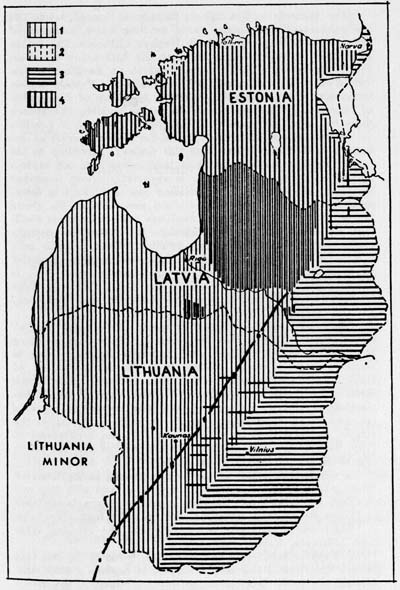Editor of this issue: Thomas Remeikis
Copyright © 1964 LITUANUS Foundation, Inc.

|
LITUANUS
LITHUANIAN
QUARTERLY JOURNAL OF ARTS AND SCIENCES
Volume 10, No.2 - Summer 1964
Editor of this issue: Thomas Remeikis ISSN 0024-5089
Copyright © 1964 LITUANUS Foundation, Inc. |

|
Book Review:
A COMPREHENSIVE STUDY
OF FARM-HOUSES
IN THE BALTIC AREA
Gustav Raenk. DIE BAUERNHAUSFORMEN IM BALTISCHEN RAUM. Wuerzburg: Holznen-Verlag. 1962 ("Marburger Ostiorschungen". Band 17) Herausgegeben von Hellmuth Weiss in Auftrage des Johann Gottfried Herder - Forschungsrates e.V.). 120 pp.. 58 figs.
Prof. G. Raenk, a noted Estonian ethnologist working at the University of Stockholm, has written a very valuable study of traditional Baltic dwellings. He evaluates and selects critically from the scattered description and notes in early literature (from the fifteenth century) and uses the materials of newest investigations on the forms of the Lithuanian, Latvian, and Estonian farm-houses and their evolution. The synthetic conclusions of the author on the oldest type of Lithuanian house, called namas (this is the oldest type, still found in Western Lithuania at the benginning of twentieth century), as well as the conclusions on the origin of Lithuanian and Latvian anteroom-kitchen-dwellings, smoke-houses, bath-houses, and the Estonian dwelling barn, throw a new light on this quite complicated problem. The author is well qualified for such a study. He has investigated the subject matter of his study fifteen years in Estonia, visiting also other countries, including Lithuania, and since 1944 continues research activities in Sweden. In his published works and studies G. Raenk concentrates on the evolution of dwelling culture in Northern and Eastern Europe.
Indicative of the scope of the work is its content. Besides the Introduction, List of Illustrations, and Bibliography, the following headings appear: I. The Lithuanian Old-House and Its Parallels Elsewhere; II. Smoke-house and Bath-house; III. Anteroom-Kitchen-Dwelling; IV. The Dwelling Barn; V. Conclusion. The area of investigation includes all ethnographic Lithuania (with Lithuania Minor and Vilnius territory), Latvia, and Estonia. The author analyzes in detail those types of dwellings which were universal in the farms and villages of the Baltic area during the nineteenth an the beginning of the twentieth centuries. Besides historical sources, the author also utilizes philological data to explain the evolution and names of dwellings. To determine the connections of the Baltic area dwellings with the general dwelling culture of Europe, dr. Raenk considers the Slavic, German, and Scandinavian research on farm-houses.
| Distribution of Baltic farm-house
types: (1) anteroom-kitchen dwelling, (2) Estonian-Swedish variation of anteroom-kitchen -dwelling, (3) smoke-house, (4) barn-dwelling. The dot-and-dash line represent the approximate dividing line between types (1) and (3). (As published by G. Raenk in his study reviewed here, p. 39). |
 |
The author considers the old Lithuanian house (namas) as the remnant of the original Baltic dwelling house, examples of which survived to our day only in Western Lithuania. The author emphasizes on several occasions that the Lithuanian materials are of special significance to the research on dwelling culture. The Western type anteroom dwelling meets the Eastern smokehouse type in the Lithuanian territory. In a map of distribution of farm-house types, the author draws the dividing l;ne btween these two types along the line Vilkaviskis - Kaunas - Rokiskis (in Lithuania) and Eastern Latvia to the Eastern corner of Estonia (see the map printed with this review). According to the latest research in Lithuania since 1956, which was not utilized by the author, this dividing line is apparently drawn somewhat too far to the east. A precise dividing line is difficult to determine for in Central Lithuania (in the area between the rivers Dubysa and Nevežis) anteroom dwellings and smoke-house dwellings are intermixed. In his conclusions the author convincingly shows that the anteroom-kitchen-dwelling, which prevails over a wide area of Central Europe and is known under the name of "Franconian farm house", and the smoke-house type, which is known among the Slavs, evolved in the Baltic from the older traditions of the Lithuanian old-house (with an open fire-place) and the bath-house (with an oven).
The author agrees with the viewpoint of the noted Swedish scholar Sigurd Erixon, that the original Scandinavian dwelling house, called eldhus, replaced older tent type dwellings, came to Scandinavia ca. eleventh century from the eastern shores of Baltic, i.e. from the lands of the Balts. The cabin construction (built of logs) eldhus is a house of the same type as the Lithuanian namas, without ceilings and with open hearth. Such houses are also called megaron-type, origin of which is found in the antique Greek architecture, for example in the excavations of Troy. Such houses were used in Eastern Europe and the Baltic area much earlier than in Scandinavia.
A substantial portion of the book is devoted to the Estonian dwelling-barn, which is a joint building of a barn with kiln and dwelling, and known only in Estonia and northern borderlands of Latvia. Its origin is connected with the older bath-house type.
The work is illustrated extensively with the dwelling types from Lithuania, Estonia, and Latvia.
The special importance of this work
is found in the fact that for the
first time it has been attempted to explain a quite complicated origin
and development of dwelling houses of the Baltic farmers, utilizing
historical sources as well research and inventory of farm-houses during
the independence period of the Baltic states. Smilar economic and
social conditions are reflected in very related peasant architecture in
all three Baltic republics. Publication of the work by a West-German
publisher, under the auspices of the Herder Institute, assures a proper
dissemination
of the book throughout the scientific world.
J. Gimbutas